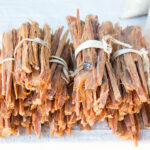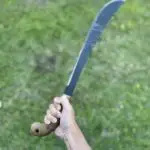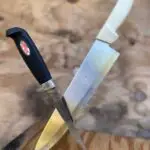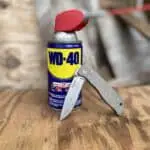Down is one of the best insulating materials known to man when it pertains to keeping out the winter cold!
Down even rivals some of the best synthetic materials that we can manufacture, which is why down jackets are still so popular.
But how do you prevent the feathers from poking through the fabric and coming out of your down jacket?

If you have recently purchased a down jacket, you may be dismayed to notice that some feathers protrude through the fabric from time to time and fall out. If you are not familiar with down, you may think this is a problem, but this is not usually the case.
This page contains affiliate links. As an Amazon Associate, I earn from qualifying purchases.
Table of Contents
- Is It Normal For Down Jackets To Lose Feathers?
- How Can You Reduce Feather Shedding From A Down Jacket?
- How Should You Wash A Down Jacket?
- Conclusion
Is It Normal For Down Jackets To Lose Feathers?
You cannot prevent feathers from coming out of a down jacket. Gently pull the feather back inside the fabric to reposition it inside the jacket. Rub over the fabric where the quill protruded to re-align the fabric and close the hole. Over time the down will settle and come out of the jacket less.
Down insulated jackets have been popular for both fashion and function for decades but have become very popular for outdoor activities in cold conditions for their thermal retention qualities.
Many modern ski jackets, hunting jackets, or general cold-weather outdoor jackets for camping and hiking, still use down as an effective insulator over synthetic products.
Down is popular because it retains its loft or puffiness up to 3-times longer than most synthetic insulating products.
Down is made from goose or duck feathers, which have a rigid spine, called the quill, and it is normally this part the pieces the fabric of the jacket and allows the down to come out.
It is normal for down jackets to lose feathers, and it will continue to do so periodically throughout the lifetime of the jacket.
The shedding of down will be more prolific on a new jacket, and it will lose what seems to be a large amount of down in the beginning. This is normal and is nothing to be alarmed about.
As the down settles down inside the fabric, it will come out on a less frequent basis. This process may take up to 2 or 3-months of regular wear.
Sometimes, frequent shedding of down indicates an inferior product, which is often the case if an inferior fabric is used for the jacket or inferior down quality. The quill on the down feathers from an older goose is rounded, while the quill from the feathers of a young goose is more pointed.
Thus, the down from older or adult geese will not come out of the jacket as much as an inferior down from a younger goose. Inferior fabric and stitching processes can also result in a down jacket losing more feathers than a higher-quality product.
How Can You Reduce Feather Shedding From A Down Jacket?
An aspect of a down jacket that you will need to come to terms with is that it will shed feathers from time to time. The frequency of feather shedding will depend on the quality of the down, the quality of the jacket, and how new the jacket is.
While there are no steps to prevent the down coming out periodically, there are some things you can do to lessen the number of feathers your jacket sheds.
Never Pull Feathers Out Of A Down Jacket
The first strategy is to never pull a down feather out of the jacket. If you notice a feather sticking through your jacket’s fabric, the first instinct is to pull the feather out.
This practice will only widen the hole that the feather comes through and will leave a larger opening through which other feathers will escape.
The preferred method to deal with an escapee feather is to pinch the feather and gently work it back inside the jacket rather than pull it out. Then rub the fabric gently with your fingers to re-align the fibers and close the hole.
Use The Fluff-Cycle On Your Clothes Dryer
The feathers start to protrude from the fabric because the down starts to compress or flatten during normal wear as they lose some of their puffiness.
Another solution that works quite well is restoring the puffiness of the down, which prevents the quills from piercing the jacket’s fabric.
This can easily be achieved by putting the down jacket in your clothes dryer and running the machine on a fluffing cycle with no heat for 10 to 15-minutes.
The air pushed into the down will cause the down fibers to puff up, limiting the quills’ contact with the fabric surface. This will effectively limit the amount of down that is shed but not prevent it altogether.
How Should You Wash A Down Jacket?
Down is a delicate product that needs proper care to ensure it stays puffy and able to insulate you from the cold. Washing your down jacket improperly is one of the fastest ways to destroy the jacket and reduce its insulating properties.
Here is the correct way to wash a down jacket in a washing machine.
- Use the gentle cycle on the washing machine. A gentle or delicate wash cycle is perfect for down jackets.
- Do not use high heat. It is best to cold-wash your down or use a very low heat cycle below 86-Fahrenheit or 30-Celsius.
- Do not spin dry. The spin-dry cycle is too vigorous for down which becomes very heavy when wet. The weight of the wet feathers can damage the fibers in the spin cycle.
- Let the jacket drip dry. Do not wring out the jacket, but rather place it lying flat on a drying rack to drip dry.
- Use a clothes dryer to fluff it up. When the jacket is almost dry, you can place it in a tumble dryer or clothes dryer with no heat for 10 to 15-minutes to fluff the down back up.
Conclusion
There is no way to prevent down from shedding from your down jacket. It is a normal event that will occur periodically. When the jacket is new and the down is beginning t settle, shedding some feathers will be a more frequent and prolific event than a jacket that has aged a little.
You can expect a new down jacket to shed down quite substantially for the first 2 to 3-months of regular wear, after which the frequency will stabilize and reduce.

You can limit the feather loss by not pulling any feathers out but rather working them back into the jacket’s fabric. You can also periodically puff the down up in a cool fluff cycle on a clothes dryer.
Down is still a popular insulator in many extreme cold clothes and will continue to be the go-to filling until we find a substitute with equivalent or superior qualities.
Thanks for reading!
- Is Fatwood Safe for Wood Stoves? Here’s What You Should Know

- Machete vs Cutlass: Differences & Uses Explained!

- Fillet Knife vs Chef Knife: Pros, Cons, and Differences

- Do Game Cameras Make Noise? And Do They Spook Deer?

- Can You Use WD-40 on a Pocket Knife?

- Does Thermacell Work on Flies? What About Other Insects?

- Can Bears Smell Thermacell? Here’s What You Should Know

- Is It Legal To Put Trail Cameras on Public Land? A State by State Guide

- Why Do Bears Attack Trail Cameras & How To Prevent It

